Research - (2022) Volume 10, Issue 12
PHYTOCHEMICALS ANALYSIS OF SOME PARTS OF IXORA COCCINEA PLANT AND POTENTIAL ANTI-ULCER EFFECTS ON WISTAR RATS
Onyemata K Esther1, Maryam Yau Gimba1, Sani Sambo Datsugwai Mohammed1 and Senol Dane2*
*Correspondence: Senol Dane, Department of Physiology, Faculty of Basic Medical Sciences, College of Health Sciences, Nile University of Nigeria, Nigeria, Email:
Abstract
Background and aim: The menace of the disease “ulcer” continues to extend within the population in a geometric progression, however, no viable cure may be said to be available to the populace. Humans all around the world suffer from stomach ulcers, which have a high morbidity and death rate. A medicinal plant is one that has the potential to be utilized for therapeutic reasons or which contains chemicals that can be used as precursors for the production of effective pharmaceuticals. Phytochemicals aid in the stimulation of immune responses and Immunity against a variety of diseases and are found in the many fruits and plants. The goals of this study are to obtain crude ethanolic extracts of the different parts of the plant (the stem, the leaves, and the flowers), and to carry out the phytochemical screening of the ethanolic extract of the different parts of the plant and study the anti-ulcer potential of the different concentration (200m/kg, 400mg/kg,600mg/kg) of the plant and determine the serum parameters. Materials and Methods: Fresh whole plant (stem, leaves & flowers) of Ixora coccinea were collected and ethanolic extract of the plant was obtained. Phytochemical analysis was used to determine the presence of secondary metabolites in Ixora coccinea. Animals were purchase from National institute for pharmaceutical research and development. Animals were randomized into six (6) groups A-F and treated as described. Fasting blood sugar was determined using on call plus Glucometer. Gastro protective effect of crude ethanol extract of Ixora coccinea was conducted, the ulcerated surfaces in each stomach and for each group the result was expressed in mm of mean ulcer index. Results: Result from this study showed the phytochemical screening of the different parts (leaves, stem and flowers) of Ixora coccinea was achieved the using the ethanolic extract. However, the flowers revealed more of the phytochemicals such as flavonoid (14.10%), saponin (11.15%), tannin (m15.34%), alkaloid (10.80%), glycoside (0.89%), and phenol (4.39%) hence used to carry out the research. Conclusion: The administration of 200mg/kg body weight of Ixora coccinea flower extract conferred a significant amount of gastric protection against HCl induced ulcer as percentage ulcer inhibition, serum albumin and total protein in the stomach and serum compared significantly with the group that received 20mg/Kg of Omeprazole.
Keywords
Phytochemicals, Ixora coccinea plant, Anti-ulcer effect
Introduction
Medicinal plants have long been employed as a rich source of antimicrobials in many parts of the globe [1]; phytochemicals are naturally occurring chemical components in plants that provide organoleptic qualities and color to plants [2]. Phytochemicals aid in the stimulation of immune responses and Immunity against a variety of diseases is also provided. Phenols, tannins, flavonoids, saponins, carbohydrates, alkaloids, phytosterols, and other phytochemicals have been identified to show therapeutic and physiological properties [3].
Ulceration is a common ailment all over the world. According to all available statistics, at least 10% of the adult population is afflicted within their lifespan. Peptic ulcer disease, also characterized as peptic, is a defect in the mucosal membrane surface of the abdomen [4]. Abdominal pain, nausea, epigastric gnawing, heartburn, acid eructation, hemorrhage, anemia, weight loss, and vomiting are all symptoms of a peptic ulcer [5]. Stomach ulcers are caused by an imbalance in the gastric mucosa's tissue layer destructive (acid and pepsin) and protective (mucous, PGE2, and PGI2) mechanisms. Acid secretion may be a physiologically vital function of the stomach, as gastric acid (HCl) induces a pepsinogen substance that helps to initiate the digestive biological process [6]. An herbal drug that is a fast-emerging treatment for ulcers is an herbal drug that is an alternative to current artificial medicine, owing to cheaper pricing and fewer side effects [7]. The leaves of Ixora coccinea Linn. (Family: Rubiaceae) possesses inhibitory and reactive element species scavenging effects, and the leaf and stem are used as an ablution for infantile diarrhea [8].
The menace of the disease “ulcer” continues to extend within the population in a geometric progression, however, no viable cure may be said to be available to the populace. Humans all around the world suffer from stomach ulcers, which have a high morbidity and death rate. The need for effective and affordable medications in the prevention and treatment of diseases is a significant concern in global health care. The research studied how effective the flowers of the Ixora coccinea plant are against ulcer due to the presence of its phytochemicals which was screened for qualitatively and quantitatively.
Materials and Methods
Plant Material (Collection and Preparation)
Fresh whole plant (stem, leaves & flowers) of Ixora coccinea were collected from the main campus of Nile University of Nigeria. Authentication followed at the National institute for pharmaceutical research and development herbarium with the voucher number NIPRD/H/8315. Temperatures were kept at room temperature for 10-14 days while the weather was dry to allow the plant materials to air dry. We then used a Soxhlet extractor to extract the dried plant's powder (300g) from 1500L of 100% ethanol. Evaporation was performed using an IKA RV10 series Rotary Evaporator, and the extracted material dried using a NUVE-NB20 water bath. Samples of the concentrated extract were stored in desiccators until needed.
Animals
The pharmacology and toxicology section at the National Institute for Pharmaceutical Research and Development provided us with 30 healthy adult wistar albino rats weighing 170±20g. For ten days, the animals were housed at ambient temperature and humidity in an area that was free of predators (25 degrees Celsius and 70% relative humidity). There was no shortage of water or food for the animals, who were fed the usual pellet diet. An ethical framework for animal scientific research was followed in this study.
Animals were randomized into six (6) groups A-F and treated as described.
A: Control (no treatment group)
B: Negative control (fed water untreated)
C: Positive control (received 20mg/kg of omeprazole)
D: Received 200 mg/kg of the extract
E: Received 400 mg/kg of the extract
F: Received 600 mg/kg of the extract
Other materials, equipment and reagents
Omeprazole oral tablet was used as the standard drug, it contains 20 mg of omeprazole. Omeprazole is the first drug of a new class of medications known as acid pump inhibitors. These medications limit stomach acid production at the final stage of the acid secretory pathway. As a result, they lower both basal and stimulated acid secretion regardless of the stimulus. other materials were, Gas chromatography-Mass spectrometry machine (Gc-Ms) Salkowski reagent, Ferric chloride (FeCl3) solution, Sodium hydroxide (NaOH) solution, Ammonia (NH3) solution, concentrated sulphuric acid (H2SO4), Sodium bi-sulphate (NaHSO4) [9].
Phytochemical analysis was conducted using the method described by Roghini and Vijayalakshmi (2018) slightly modified to determine the presence of secondary metabolites in Ixora coccinea [10].
Saponin: In a test tube, 1 ml of plant extract was diluted with distilled water and agitated for 15 minutes. A 1 cm layer of foam formed when saponins were present.
Flavonoids: 2-3 drops of sodium hydroxide solution were added to 1 mL of plant extract. The presence of flavonoids was revealed by the production of an acute yellow color.
Phenols: 1 ml of the extract was mixed with 1 ml distilled water and a few drops of 10% ferric chloride. The presence of phenols was revealed by the formation of a blue tint.
Tannins: 2 ml ferric chloride (5%) was added to 1 ml of extract. Tannins were detected by the formation of a dark blue black.
Alkaloids: 2 mL strong hydrochloric acid was applied to 2 mL extract. The Salkowski reagent was then added in three drops. The presence of alkaloids was revealed by the presence of white precipitate.
Glycosides: 2 mL extract, 3 mL chloroform, and 10% ammonia solution were added to 2 mL extract. The inclusion of glycosides was shown by the formation of a pink color.
Quantitative analysis
The phytochemicals were analyzed quantitatively using GC-MS method to reveal the actual amount contained in the ethanolic extract of flowers of Ixora coccinea.
Fasting blood sugar
Fasting blood sugar of the rats was determined using On Call Plus Glucometer, has a strip that is thin with a chemical reagent which works the On Call Plus Blood Glucometer to measure the glucose concentration in whole blood. The strip was inserted into the meter and the meter beeped indicating that the meter is on, blood was applied to the sample tip of the test strip there was a beep indicating that sample is sufficient and the measurement has started, and values were recorded for 3 days.
0.6 M HCl ulcer model
Gastroprotective effect of crude ethanol extract of Ixora coccinea was conducted as described by the method of Deshpande et al. (2003) slightly modified [11]. Initially, they were randomly selected and divided into 6 groups of 4 rats each according to similar range of body weight as shown in Table 1, Group 1 and 2 served as the control and negative control respectively that received water; group 3 served as the positive control that received omeprazole; groups 3 to 5 received the Ixora coccinea at doses of 200, 400 and 600 mg/kg body weight, respectively. The animals were fasted for 48 hours, and the extract was administered during that per one hour after treatment with the extract, rats with the average weight of 150 g were given 1 ml, 217.75 g of body weight received 1.5 ml, the group weighing an average of 299.5 g received 2 ml, while animals with 360 g of body weight received 2ml of 0.6 M HCl orally as an ulcerogenic. Two hours after treatment with HCl, all the rats were sacrificed in a chloroform chamber. On each animal, ventral midline incision was made on the abdomen to expose the stomach, the ulcerated surfaces in each stomach, and the result for each group was expressed in mm of mean ulcer index as described by the method of [11].
| Phytochemicals | Leaves | stem | Flowers |
|---|---|---|---|
| Flavonoids | + | + | + |
| Saponins | - | + | + |
| Phenols | + | + | + |
| Alkaloids | + | + | + |
| Tannins | + | + | + |
| Glycosides | - | - | + |
| Key: present (+) and absent (-) | |||
Table 1: Presence of phytochemicals in different parts of Ixora coccinea.
Percentage inhibition of ulceration
The percentage inhibition of ulceration was expressed as a percentage of the control by using the following formula:
Percentage inhibition=UIulcercontrol-UItreated/Uulcercontrol X 100
Blood collection and preparation of serum
Blood was collected via cardiac puncture under slight anesthesia with diethyl ether. Whole blood was transferred into plain tubes and serum was collected for analysis. Blood was collected in plain sterile sample bottles for biochemical assays. The blood in the plain bottles was left to stand for 30 minutes for blood cells to clot. To allow separation of blood cells and sera properly, the blood samples were spun in NUVE NF-400 Centrifuge at 4000rpm for 10 minutes, the sera were thereafter aspirated using Pasteur pipette into dry sterile sample bottles, labelled appropriately and further biochemical analysis were conducted. Absorbance values were read with molecular devices Spectra Max 340, 96-well Microplate reader.
Determination of biochemical parameters
Alanine aminotransferase (ALT), aspartate aminotransferase (AST) and alkaline phosphatase (ALP), Albumin, Total bilirubin, Direct bilirubin, Creatinine, Urea, Amylase, Trypsin, Pepsin, the procedures were carried out as prescribed in the kit’s manual.
Statistical analysis
An experiment's results are summarized as mean plus standard deviation (SEM). Statistical analysis was implemented using computer software SPSS 20.0 version statistical package program (SPSS, Chicago IL). Variables were compared between groups using a one-way analysis of variance. Duncan's Multiple Range Test was used to establish the significance (Post hoc comparisons) of the various treatments. P < 0.05 was judged statistically significant for differences in means.
Results
Qualitative and quantitative phytochemical screening
Table 1 is the result for the qualitative analysis for phytochemicals in different part of Ixora coccinea analyzed for. Flavonoids, Phenols, Tannins, Alkaloid were present, while Glycosides,Saponins were absent in the leaves. While in the stem Flavonoids, Saponins, Phenols, Tannins, Alkaloids were present only Glycoside was absent. However, in the flowers all the phytochemicals under study were present.
Table 2 shows the amount in percentage of the quantity for each phytochemical screened for in the flowers. Tannin was most abundant hence the antiulcer property exhibited was not surprising. Tannins have been shown to present antioxidant activity, promote tissue repair, exhibit anti-Helicobacter pylori effects, and are involved in gastrointestinal tract anti-inflammatory processes.
| Constituents | Amount (%) |
|---|---|
| Alkaloids | 10.8 |
| Flavonoid | 14.1 |
| Saponin | 11.15 |
| Glycosides | 0.89 |
| Phenol | 4.36 |
| Tannins | 15.34 |
Table 2: Quantitative Analysis of phytochemicals present in the flowers of Ixora coccinea.
Fasting blood determination in rats prior to ulcer induction
Figure 1 showed the fasting blood sugar level of the rats which was determined for three days, the level of glucose was high on day one, there was significant decrease on day two and three which ensured that the rats were really fasted to clear up food in the stomach that provided a protective means on the stomach wall prior to induction of ulcer, this is supported by [12] that the major goal of diet is to avoid extreme elevations of gastric acid secretion and the direct irritation of gastric mucosa.
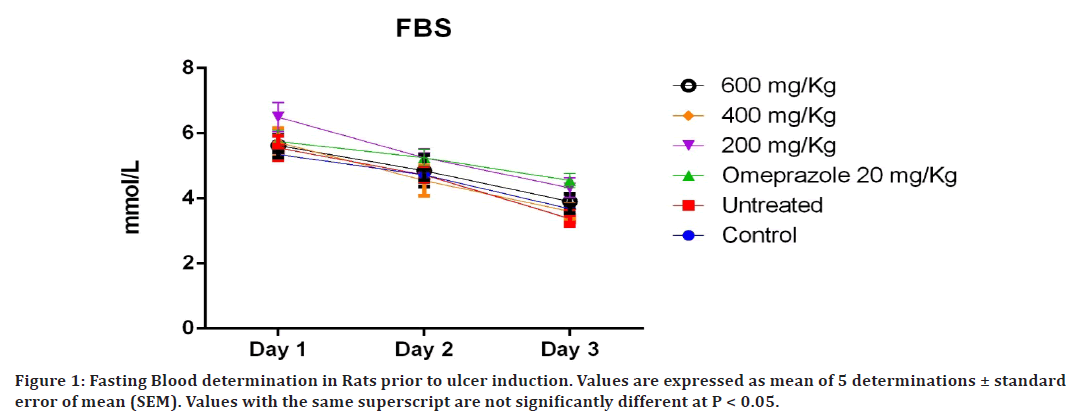
Figure 1. Fasting Blood determination in Rats prior to ulcer induction. Values are expressed as mean of 5 determinations ± standard error of mean (SEM). Values with the same superscript are not significantly different at P < 0.05.
Percentage of ulceration and inhibition and Image collage of ulceration
The percentage ulceration showed that the ulceration has taken place because if we compare the groups 400 and 600 mg/kg having 2.64±0.29 and 4.36± 0.74 respectively and omeprazole and 200mg/kg there was a significant decrease of 0.95 ± 0.45 and 0.89± 0.38 respectively all compared to the control group. Percentage inhibition was dependent as 200mg/kg of the extract has the most potential for inhibiting ulcer compared to omeprazole, 400mg/kg and 600mg/kg had significantly lower effect of inhibition on the stomach wall and 400 mg/kg was not as low as 600 mg/kg (Table 3).
| Group (Treatment) | Area of stomach (mm2) | Area of ulceration (mm2) | % Ulceration | % Ulcer inhibition |
|---|---|---|---|---|
| Control | 7.64 ± 0.14 | 0.006 ± 0.0003 | 0.008 ± 0.004 | 98 |
| Untreated | 7.68 ± 0.40 | 2.46 ± 0.16 | 3.53 ± 0.98 | - |
| Omeprazole 20 mg/Kg | 7.69 ± 0.19 | 0.39 ± 0.02 | 0.97 ± 0.45 | 73.37 |
| 200 mg/Kg extract | 6.09 ± 0.36 | 0.42 ± 0.06 | 0.89 ± 0.38 | 74.79 |
| 400 mg/Kg extract | 7.61 ± 0.17 | 1.18 ± 0.12 | 2.64 ± 0.29 | 40.51 |
| 600 mg/Kg extract | 8.95 ± 0.43 | 1.62 ± 0.07 | 4.36 ± 0.74 | -23.51 |
Table 3: Percentages of ulceration and inhibition.
After sacrificing the rats, the stomach was excised, rinsed in sucrose solution, it was then placed on petri dish and pictures of the stomach was captured as observed in (Figure 2). Using Image J software, the pictures of the ulceration surfaces were analyzed, and the ulcer index was calculated using the formula.
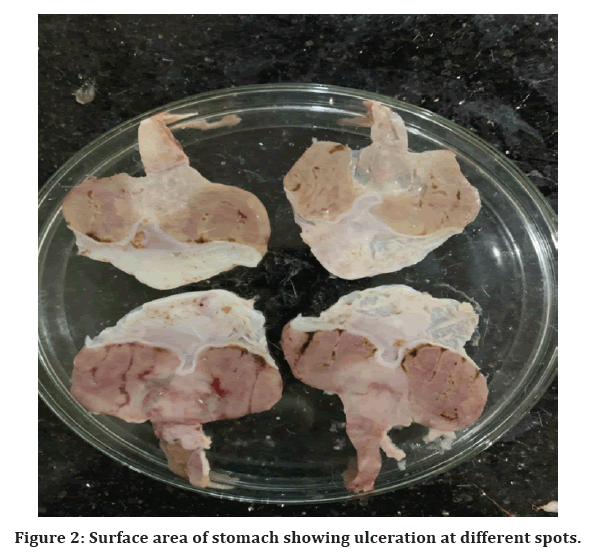
Figure 2. Surface area of stomach showing ulceration at different spots.
Figure 3 shows the image collage of ulceration. A shows the stomach area of control rat. B is the stomach area of untreated rat and C shows the highlighted area of ulceration.
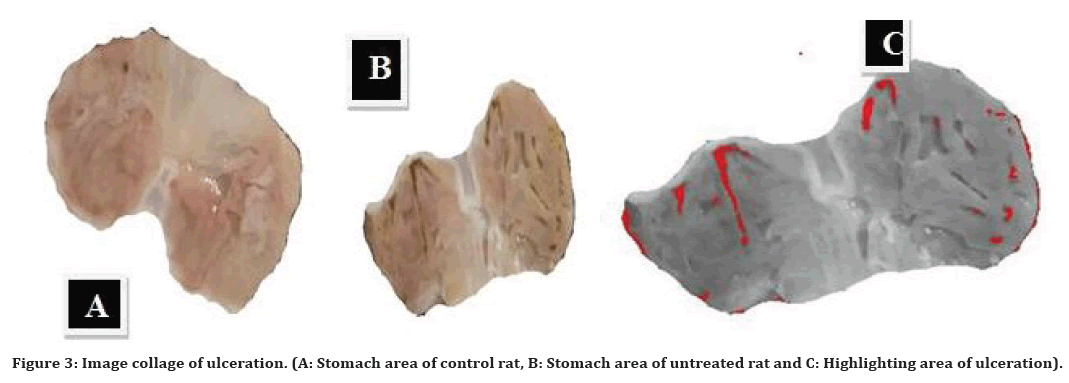
Figure 3. Image collage of ulceration. (A: Stomach area of control rat, B: Stomach area of untreated rat and C: Highlighting area of ulceration).
Serum parameters
There was a marked elevation of total protein concentration in serum in the untreated group compared to the control group, however the administration of 20mg/kg of omeprazole and 200mg/kg of the extract reduced this protein concentration to a significant level and its comparable to the control and this is in line with previous study (Figure 4). However, the groups that received 400 and 600 mg/kg of the extract reduced significantly but not comparable to the control. In the stomach it is expected that some of the protein content might be released as a result of hyper acidity or there was some wasting of the gastric enzyme. The total protein in the untreated group was the lowest compared to the control and the group that received omeprazole. However, there is no significant difference in the groups that received 200, 400 and 600mg/kg of the extract.
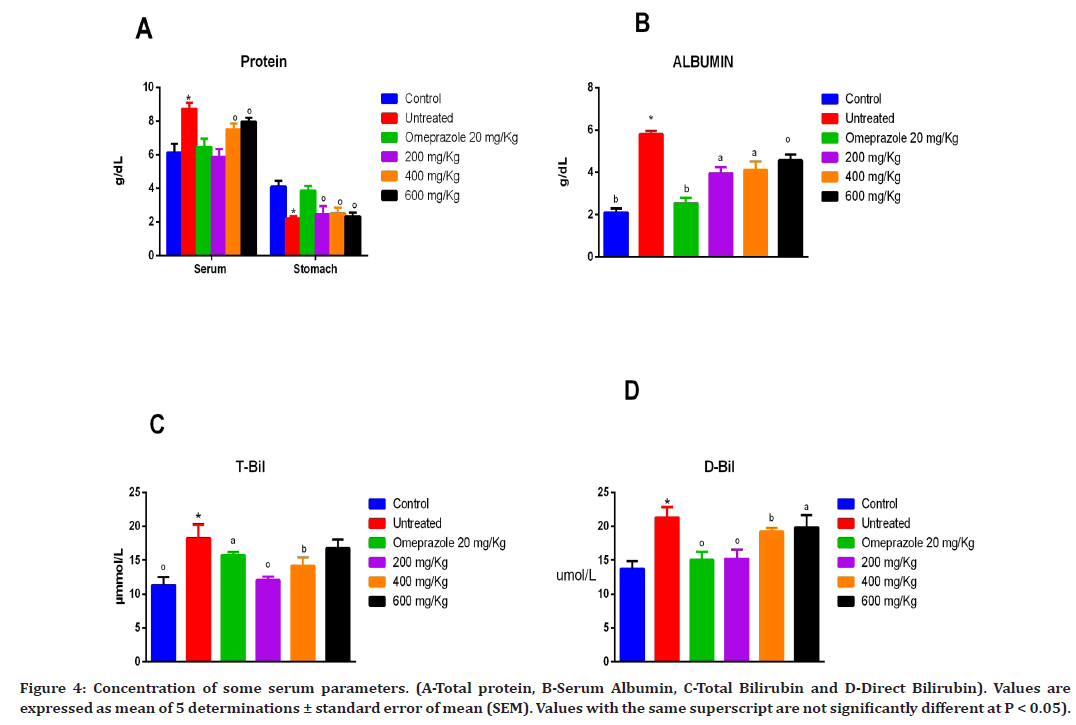
Figure 4. Concentration of some serum parameters. (A-Total protein, B-Serum Albumin, C-Total Bilirubin and D-Direct Bilirubin). Values are expressed as mean of 5 determinations ± standard error of mean (SEM). Values with the same superscript are not significantly different at P < 0.05).
Albumin concentration here was seen to be elevated the untreated group when compared to the control group; however, there was no significant difference between the group that received omeprazole and the control. There was a significant decrease in the other groups, but they were not comparable to the control.
In total bilirubin there was a marked elevation in the untreated group. However, the 200mg/kg extract group and the control group showed no significant differences. There was a significant decrease in the other group, but they were not comparable to the control group.
For Direct bilirubin, there was a marked elevation in the untreated group, and there was no significance difference between the group that received omeprazole and 200mg/kg of the extract and they comparable to the control, however there was a significant decrease in the other groups, but they were not to the control.
Some enzyme markers in serum and stomach
The activities of ALP, ALT and AST were determined in both the stomach and serum of the animals. All these enzymes are non-functional enzymes therefore they are not supposed to be found in high concentration. Disease warrants for the leakage of these enzymes. In fig. 5, there was a marked elevation of ALP in the untreated group, there was a significant difference in the group that received omeprazole and 200mg/kg of the extract, there was also significant decrease in the groups, but they were not comparable to the control.
In the stomach, high concentration of ALP was seen in the control group, there was no significant difference between omeprazole group and 200mg/kg group, as well as 400mg/kg and 600mg/kg but however a significant decrease was seen in the untreated group.
All these varying concentrations applied the same trend to ALT and AST (Figure 5).
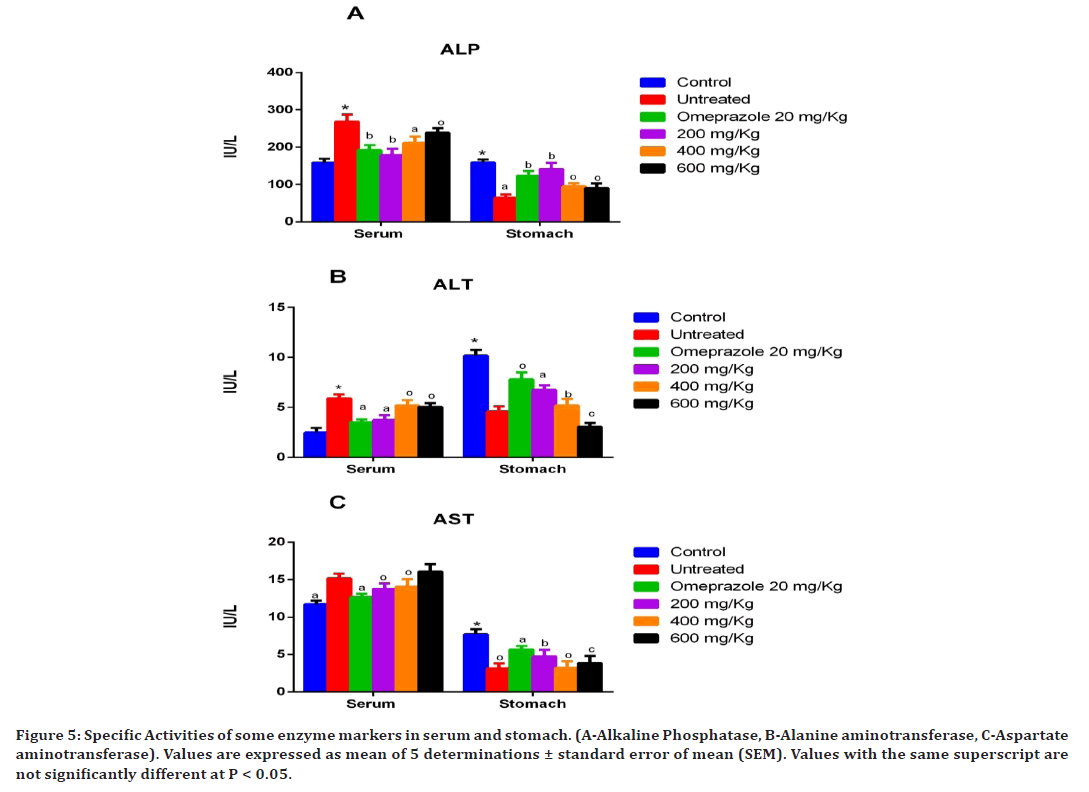
Figure 5. Specific Activities of some enzyme markers in serum and stomach. (A-Alkaline Phosphatase, B-Alanine aminotransferase, C-Aspartate aminotransferase). Values are expressed as mean of 5 determinations ± standard error of mean (SEM). Values with the same superscript are not significantly different at P < 0.05.
Kidney function parameters
There was a marked elevation of urea in the 400mg/kg group, there was a significant decrease in the group that received omeprazole and it’s comparable to the control, though 200 and 600 mg/kg dose (Figure 6). Creatinine concentration was seen to be elevated in the 600 mg/kg group; there was a significant decrease in the untreated and the group that received omeprazole. The 400 mg/ kg extract group showed no statistically significant difference from the control group.
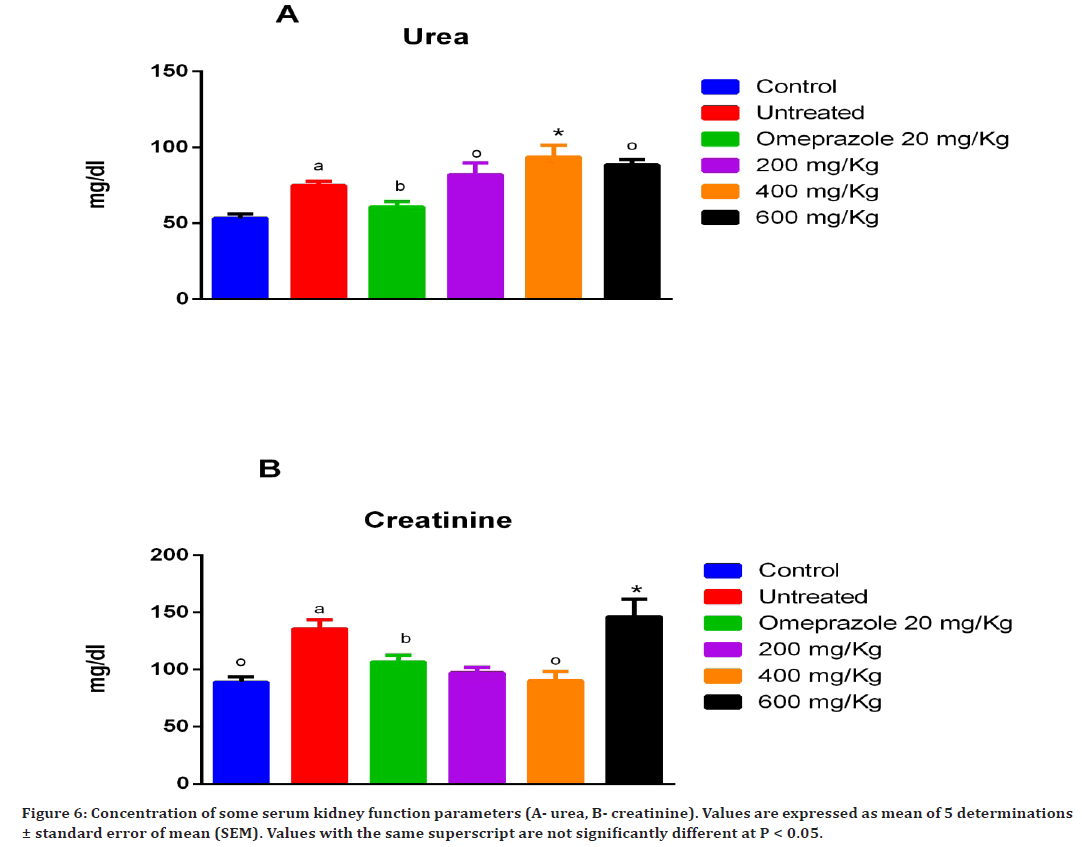
Figure 6. Concentration of some serum kidney function parameters (A- urea, B- creatinine). Values are expressed as mean of 5 determinations ± standard error of mean (SEM). Values with the same superscript are not significantly different at P < 0.05.
Some digestive enzymes
There was a marked elevation of amylase in 600 mg/kg group, however there was a decrease in the other group, but they were not comparable to the control (Figure 7). The concentration of pepsin was seen to be in the untreated group, there was a significant decrease in the other group, but they were not comparable to the control group. While the untreated group showed a considerable increase, no differences were seen between that group and the omeprazole and 200 mg/kg extract, 400 mg/ kg, or 600 mg/kg groups, which were not similar to the control group.
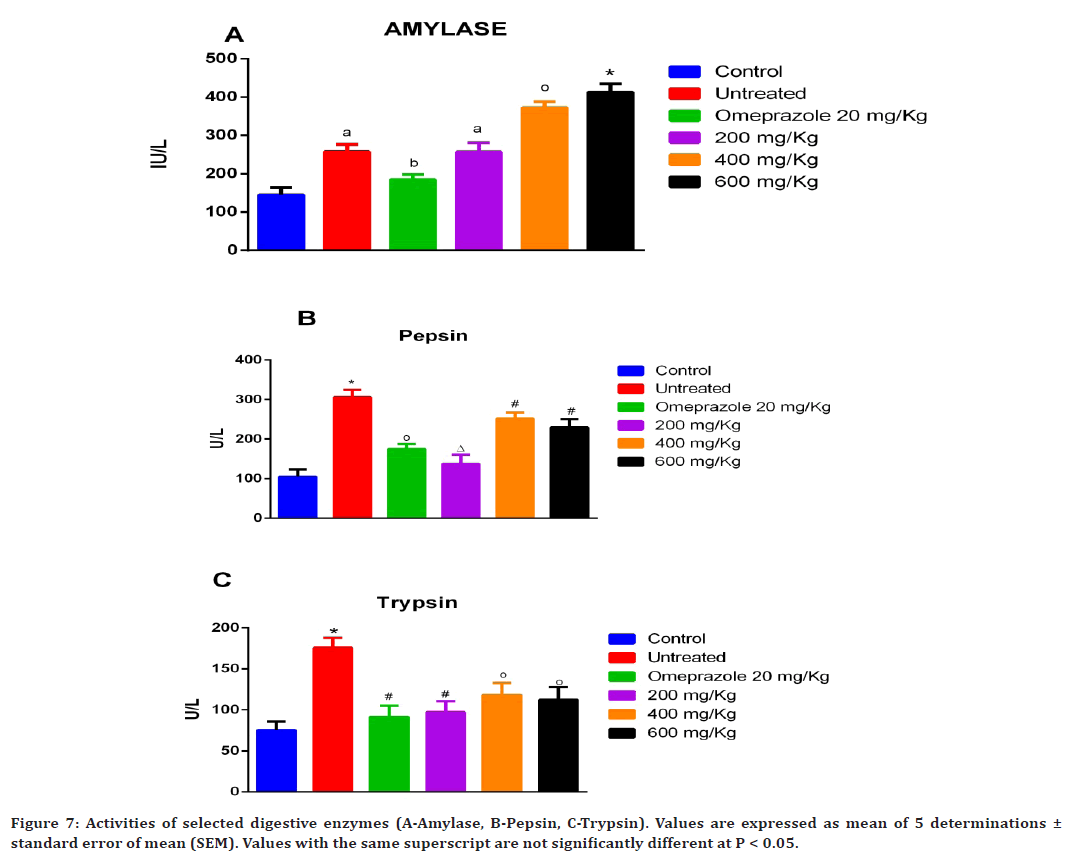
Figure 7. Activities of selected digestive enzymes (A-Amylase, B-Pepsin, C-Trypsin). Values are expressed as mean of 5 determinations ± standard error of mean (SEM). Values with the same superscript are not significantly different at P < 0.05.
Discussion
In this study, phytochemicals in different part of Ixora coccinea was screened which there was presence of Flavonoids, Phenols, Tannins, Alkaloids, and Glycosides, Saponins were absent in the leaves in while in the stem Flavonoids, Saponins, Phenols, Tannins, Alkaloids were present only Glycoside was absent. However, in the flowers all the phytochemicals under study were present and this is in line with the study of [10].
Tannin was most abundant hence the antiulcer property exhibited was not surprising. Tannins have been shown to present antioxidant activity, promote tissue repair, exhibit anti-Helicobacter pylori effects, and are involved in gastrointestinal tract anti-inflammatory processes. This is similar to De Jesus et al. 2012 in their research and in several experimental models of gastric ulcer [13]. Tannins have also been shown to be involved in the healing of gastric ulcers. The anti-ulcer actions of the flower of Ixora coccinea can be explained by the presence of tannins as well as the quantity of tannins.
The level of glucose was high on day one, there was significant decrease on day two and three which ensured that the rats were really fasted to clear up food in the stomach that provided a protective means on the stomach wall prior to induction of ulcer, this is supported by Marotta and Floch (1993) that the major goal of diet is to avoid extreme elevations of gastric acid secretion and the direct irritation of gastric mucosa [12].
The percentage ulceration showed that the ulceration has taken place because if we compare the groups 400 and 600 mg/kg having 2.64±0.29 and 4.36±0.74 respectively and omeprazole and 200mg/kg there was a significant decrease of 0.95±0.45 and 0.89±0.38 respectively all compared to the control group. Percentage of inhibition was dependent as 200 mg/kg of the extract has the most potential for inhibiting ulcer compared to omeprazole, 400 mg/kg and 600 mg/kg had significantly lower effect of inhibition on the stomach wall and 400 mg/kg was not as low as 600 mg/kg.
After sacrificing the rats, the stomach was excised, rinsed in sucrose solution, it was then placed on petri dish and pictures of the stomach was captured as observed in (Figure 2). Using ImageJ software, the pictures of the ulceration surfaces were analyzed, and the ulcer index was calculated using the formula.
Total protein measures the total amount of albumin and globulin, it is used to check if there is kidney or liver disease. High levels of total protein indicate dehydration or liver disease. There was a marked elevation of total protein concentration in serum in the untreated group compared to the control group, however the administration of 20 mg/kg of omeprazole and 200 mg/ kg of the extract reduced this protein concentration to a significant level and its comparable to the control and this is in line with previous study. However, the groups that received 400 and 600 mg/kg of the extract reduced significantly but not comparable to the control. In the stomach it is expected that some of the protein content might be released as a result of hyper acidity or there was some wasting of the gastric enzyme. The total protein in the untreated group was the lowest compared to the control and the group that received omeprazole. However, there is no significant difference in the groups that received 200, 400 and 600 mg/kg of the extract.
Albumin functions primarily as a carrier protein for steroids, fatty acids, and thyroid hormones and plays a role in stabilizing extracellular fluid volume [14]. Its high concentration in the blood refers to certain things there is an injury that relates to water loss. Albumin has been seen to increase in some gastrointestinal disease that was trying to relate with. Albumin concentration here was seen to be elevated the untreated group when compared to the control group; however, there was no significant difference between the group that received omeprazole and the control. There was a significant decrease in the other groups, but they were not comparable to the control.
Heme catabolism's yellow breakdown product, bilirubin (previously hematoidin), is a yellow pigment. It is excreted in bile and urine and its elevated levels may indicate certain diseases [15]. And direct (or conjugated) bilirubin which dissolves in water (it is soluble), made by the liver from indirect bilirubin [16]. The total of bilirubin obtained from processes that has not been conjugated is termed total bilirubin [17].
In total bilirubin there was a marked elevation in the untreated group. however, the 200mg/kg extract group and the control group showed no significant differences. There was a significant decrease in the other group, but they were not comparable to the control group.
For Direct bilirubin, there was a marked elevation in the untreated group, and there was no significance difference between the group that received omeprazole and 200mg/kg of the extract and they comparable to the control, however there was a significant decrease in the other groups, but they were not to the control.
The activities of ALP, ALT and AST were determined in both the stomach and serum of the animals. All these enzymes are non-functional enzymes therefore they are not supposed to be found in high concentration. Disease warrants for the leakage of these enzymes.
ALP is released into the blood in various disorders, including obstructive jaundice and some bone diseases. Measurement of its serum level forms a common clinical test [18].
The activities of ALT are measured as one of the markers traceable to changes in the pathological condition of the liver. ALT could be used for the diagnosis of liver diseases; high levels of ALT are observed in patients with acute hepatitis and acute cirrhosis [19]. AST isoenzyme can be used as marker enzymes in the study of diagnosis of liver diseases caused by drug toxicity or by infection [20]. There was a marked elevation of ALP in the untreated group, there was a significant difference in the group that received omeprazole and 200 mg/kg of the extract, there was also significant decrease in the groups, but they were not comparable to the control.
In the stomach, high concentration of ALP was seen in the control group, there was no significant difference between omeprazole group and 200mg/kg group, as well as 400mg/kg and 600 mg/kg but however a significant decrease was seen in the untreated group. All these varying concentrations applied the same trend to ALT and AST. Creatinine is a break-down product of creatine phosphate in muscle and is usually produced at a constant rate by the body (depending on muscle mass). The creatinine blood test is used to assess kidney function. A rise in blood creatinine levels suggests only marked damage to functioning nephrons [21].
There was a marked elevation of urea in the 400mg/kg group, there was a significant decrease in the group that received omeprazole and it’s comparable to the control, though 200 and 600 mg/kg doses were not statistically different, they were not similar to control groups. Creatinine concentration was seen to be elevated in the 600 mg/kg group; there was a significant decrease in the untreated and the group that received omeprazole. The 400 mg/kg extract group showed no statistically significant difference from the control group.
Alpha-amylase is a type of enzyme (biological catalyst) that catalyzes the hydrolyses of starch into sugars, high level of amylase are signs of acute or chronic pancreatitis, the pancreas sits behind the stomach and the pancreas release starch in the digestive tract for the enzyme hydrolyze [22].
Pepsin metabolizes dietary protein into amino acids that can be absorbed by the body. This enzyme breaks down protein peptide bonds, which are the most common type of chemical link in proteins. In response to various stimuli, small basophilic cells in the deeper layers of gastric glands, known as Chief cells, produce pepsinogen [23].
Trypsin is a pancreatic serine protease from PA clan superfamily. Trypsinogen is discharged by the pancreas in an inactive proenzyme form in the digestive tract of many vertebrates. Trypsin hydrolyzes proteins and other biological processes to perform its functions. [24].
There was a marked elevation of amylase in 600 mg/ kg group, however there was a decrease in the other group, but they were not comparable to the control. The concentration of pepsin was seen to be in the untreated group, there was a significant decrease in the other group, but they were not comparable to the control group. While the untreated group showed a considerable increase, no differences were seen between that group and the omeprazole and 200 mg/kg extract, 400 mg/kg, or 600 mg/kg groups, which were not like the control group.
Conclusion
It can be concluded from this research that the phytochemical screening of the different parts (leaves, stem, and flowers) of Ixora coccinea was achieved the using the ethanolic extract. The flowers revealed more of the phytochemicals such as flavonoid, saponin, tannin, alkaloid, glycoside, phenol and used to carry out the research. The administration of 200mg/kg body weight of Ixora coccinea flower extract conferred a significant amount of gastric protection against HCl induced ulcer as percentage ulcer inhibition, serum albumin and total protein in the stomach and serum compared significantly with the group that received 20mg/Kg of Omeprazole.
Also, at 200 mg/Kg oral administration of Ixora coccinea there was significantly similar prevention of some toxicological markers (ALP, ALT, and AST) leaking from the stomach when compared with the group that received 20 mg/Kg of Omeprazole. Despite these potential antiulcer properties, the administration of the extract seemed to cause a dose dependent alteration in some kidney function parameters as well as digestive enzymes.
Recommendations
Other parts of Ixora coccinea should be investigated further as it possesses phytochemicals that may confer gastric protection against gastric ulcer. Further work is suggested to check the cytotoxicity properties of the phytochemicals should be investigated as they might have answers for some of the alterations observed in some parameters like urea and amylase observed in this study.
References
- Mahesh B, Satish S. Antimicrobial activity of some important medicinal plant against plant and human pathogens. World J Agric Sci 2008; 4:839-843.
- Yadav R, Khare RK, Singhal A. Qualitative phytochemical screening of some selected medicinal plants of Shivpuri district (MP). Int J Life Sci Scienti Res 2017; 3:844-847.
- Grover N, Patni V. Phytochemical characterization using various solvent extracts and GC-MS analysis of Methanolic Extract of Woodfordia fruticosa (L.) Kurz. Leaves. Int J Pharma Pharmaceutic Sci 2013; 5:291-295.
- Vyawahare NS, Deshmukh VV, Gadkari MR, et al. Plants with antiulcer activity. Pharmacogn Rev 2009; 3:108-115.
- Asali AM, Alghamdi MA, Fallatah SA, et al. Risk factors leading to peptic ulcer disease: systematic review in literature. Community Med Public Health 2018; 5:4617-4124.
- Sung JJ, Kuipers EJ, El-Serag HB. Systematic review: The global incidence and prevalence of peptic ulcer disease. Aliment Pharmacol Ther 2009; 29:938-946.
- Harold K, Grant DM, Mitchel J. Principles of medical pharmacology. 2007.
- Obuzor GU, Nwakanma GU. Chemical composition of essential oil of Ixora coccinea flower from Port Harcourt, Nigeria. Internat J Academic Res 2011; 3:381-384.
- McTavish D, Buckley MM, Heel RC. Omeprazole. An updated review of its pharmacology and therapeutic use in acid-related disorders. Drugs 1991; 42:138-170.
- Roghini R, Vijayalakshmi K. Phytochemical screening, quantitative analysis of flavonoids and minerals in ethanolic extract of citrus paradisi. JPSR 2018; 9:4859-4864.
- Deshpande SS, Shah GB, Parmar NS. Anti-ulcer activities of tephrosia purpurea in rats. Indian J Pharmacol 2003; 35:168-172.
- Marotta K, Floch MH. Diet and nutrition in ulcer diseases. Med Clin North Am 1993; 77:88.
- de Jesus NZ, de Souza Falcão H, Gomes IF, et al. Tannins, peptic ulcers and related mechanisms. Int J Mol Sci 2012; 13:3203-3228.
- He XM, Carter DC. Atomic structure and chemistry of human serum albumin. Nature 1992; 358:209-215.
- Liu Y, Li P, Lu J, et al. Bilirubin possesses powerful immunomodulatory activity and suppresses experimental autoimmune encephalomyelitis. J Immunol 2008; 181:1887-1897.
- Chernecky CC, Berger BJ. Laboratory tests and diagnostic procedures. 5th Ed. St. Louis: Saunders 2008; 1189-1194.
- Tietz NW. Clinical Guide toLaboratory Tests. 3rd Edn, W.B. Saunders Company, Philadelphia, 1995; 972.
- Schiele F, Vincent-Viry M, Fournier B, et al. Biological effects of eleven combined oral contraceptives on serum triglycerides, gamma-glutamyltransferase, alkaline phosphatase, bilirubin and other biochemical variables. Clin Chem Lab Med 1998; 36:871-878.
- Reitman S, Frankel S. A colorimetric method for the determination of serum glutamic oxalacetic and glutamic pyruvic transaminases. Am J Clin Pathol 1957; 28:56-63.
- Nelson DL, Cox MM. Lehninger, Principles of biochemistry. 3rd Edn. Worth Publishing: New York 2000; 153-156.
- Webb S, Dobb G. ARF, ATN or AKI? It's now acute kidney injury. Anaesth Intensive Care 2007; 35:843-844.
- Tiwari SP, Srivastava R, Singh CS, et al. An overview with special reference to alpha amylase. J Global Biosci 2015; 1886-1901.
- Heda R, Toro F, Tombazzi CR. Physiology, pepsin. treasure island (FL): Stat Pearls Publishing 2021.
- Elgendy AS, Abdelrasool MK. A literature review on trypsin enzyme. Qatar University College of Arts and Sciences 2016.
Indexed at, Google scholar, Cross Ref
Indexed at, Google scholar, Cross Ref
Indexed at, Google scholar, Cross Ref
Indexed at, Google scholar, Cross Ref
Indexed at, Google scholar, Cross Ref
Indexed at, Google scholar, Cross Ref
Indexed at, Google scholar, Cross Ref
Indexed at, Google scholar, Cross Ref
Indexed at, Google scholar, Cross Ref
Indexed at, Google scholar, Cross Ref
Author Info
Onyemata K Esther1, Maryam Yau Gimba1, Sani Sambo Datsugwai Mohammed1 and Senol Dane2*
1Department of Biology Microbiology and Biotechnology, Faculty of Natural and Applied Sciences, Nile University of Nigeria, Abuja, Nigeria2Department of Physiology, Faculty of Basic Medical Sciences, College of Health Sciences, Nile University of Nigeria, Abuja, Nigeria
Received: 17-Nov-2022, Manuscript No. jrmds-22-72182; , Pre QC No. jrmds-22-72182(PQ); Editor assigned: 21-Nov-2022, Pre QC No. jrmds-22-72182(PQ); Reviewed: 05-Dec-2022, QC No. jrmds-22-72182(Q); Revised: 09-Dec-2022, Manuscript No. jrmds-22-72182(R); Published: 16-Dec-2022
